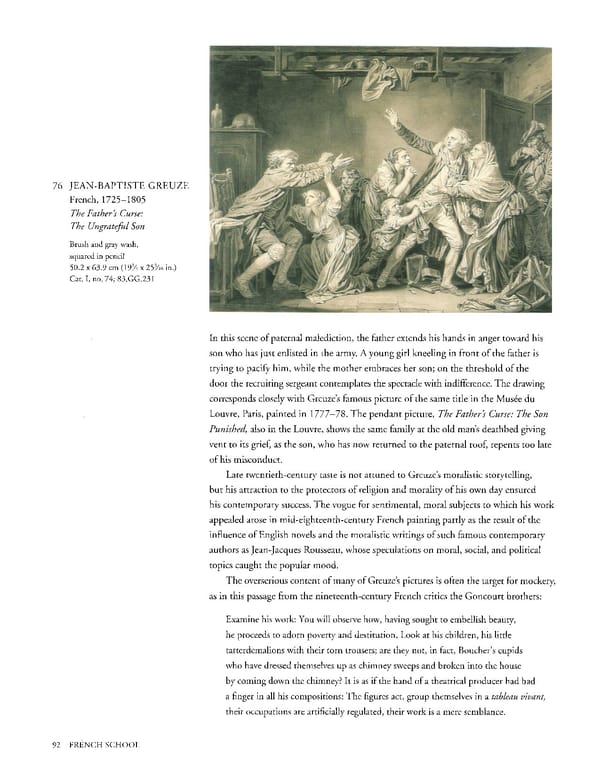76 JEAN-BAPTISTE GREUZE French, 1725-1805 The Father's Curse: The Ungrateful Son Brush and gray wash, squared in pencil 50.2 x 63.9 cm (19¾ x 25 3/16 in.) Cat. I, no. 74; 83.GG.231 In this scene of paternal malediction, the father extends his hands in anger toward his son who has just enlisted in the army. A young girl kneeling in front of the father is trying to pacify him, while the mother embraces her son; on the threshold of the door the recruiting sergeant contemplates the spectacle with indifference. The drawing corresponds closely with Greuze's famous picture of the same title in the Musee du Louvre, Paris, painted in 1777-78. The pendant picture, The Father's Curse: The Son Punished, also in the Louvre, shows the same family at the old man's deathbed giving vent to its grief, as the son, who has now returned to the paternal roof, repents too late of his misconduct. Late twentieth-century taste is not attuned to Greuze's moralistic storytelling, but his attraction to the protectors of religion and morality of his own day ensured his contemporary success. The vogue for sentimental, moral subjects to which his work appealed arose in mid-eighteenth-century French painting partly as the result of the influence of English novels and the moralistic writings of such famous contemporary authors as Jean-Jacques Rousseau, whose speculations on moral, social, and political topics caught the popular mood. The overserious content of many of Greuze's pictures is often the target for mockery, as in this passage from the nineteenth-century French critics the Goncourt brothers: Examine his work: You will observe how, having sought to embellish beauty, he proceeds to adorn poverty and destitution. Look at his children, his little tatterdemalions with their torn trousers; are they not, in fact, Boucher's cupids who have dressed themselves up as chimney sweeps and broken into the house by coming down the chimney? It is as if the hand of a theatrical producer had had a finger in all his compositions: The figures act, group themselves in a tableau vivant, their occupations are artificially regulated, their work is a mere semblance. 92 FRENCH SCHOOL
 Masterpieces of the Getty Museum: Drawings Page 92 Page 94
Masterpieces of the Getty Museum: Drawings Page 92 Page 94